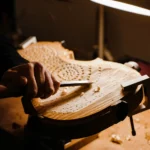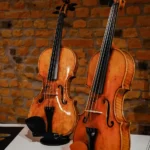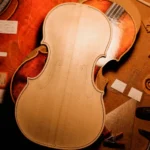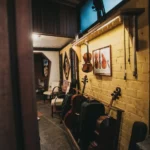French Violin Makers
Back to BlogFrench Violin Makers
Violin making is a challenging yet beautiful craft, capturing the hearts of musicians and string instrument enthusiasts worldwide. These fine instruments are tricky to learn, requiring robust skills to balance the challenging instrument while playing it.
So, it’s no surprise that violins, violas, and cellos are physically challenging to produce! This article will discuss the history behind French violin makers, featuring the perfect mix of skill, style, and accuracy to enchant music lovers.
The Heart of the French Violin-Making Tradition: A Look into the Past
The history of violin and viola-making dates back to the early 1600s in the picturesque French commune of Mirecourt, with the work of Jean de Fourcelle e Berbelin, Clabec, Demange Aulbertin, and Nicolas Gerard. The quaint northeastern community gave birth to some of the most famous viola and violin makers, boasting over 50 luthiers during the 16th century.
These instrument makers grew and mastered their craft as the Mirecourt forged its way to a guild system, transforming the country into an economic powerhouse. During 1732, Mirecourt built its guild for string instruments, ensuring the produced violin met stringent quality control guidance.
Consequently, numerous skilled instrument makers emerged, helping Mirecourt become a wealthy and reputable town, while some left the commune to pollinate the French School. The now-skilled artisans became master luthiers and returned to Mirecourt, cementing the town’s reputation by propelling the commune through a new era of music.
Thus, between the 1820s and the 1970s, Mirecourt became the center of up-and-coming violin and viola makers, including Vuillaume, Nicolas Lupot, Bernardel, Chanot, Pique, and more. Today, string instruments from Mirecourt, including violins, double basses, violas, and cellos, stand out for their craft, competitive pricing, artistry, and playability.
The Top French Violin Makers of All Time
Let’s now delve into the exceptional talents behind the well-known violins and violas of all time:
Jean-Baptiste Vuillaume
Vuillaume, the great violin maker of the 19th century, is famous due to his superior workmanship and top soloist-quality sound. He is also known for replicating classical Italian makers. Born in 1798 in Mirecourt, he comes from a family of violin makers from the French capital of violin making; he learned the art of violin making in his hometown with his father.
Years passed until he decided to move to Paris to work with acclaimed violin makers of that time. Later on, he established his own workshop in the city of Lights. Which, by the way, turned out to be one of the most prolific of that era, producing over 3000 instruments and employing many violin and bow makers.
His work period is dated from 1823 until 1875; almost two-thirds of his life was devoted to the art of violin making. With the Italian masterpieces leading their way to France, through Collectors/dealers and soloists, French luthiers started to adopt the forms of Stradivari and Guarneri. Vuillaume became famous for his precise hand skill as a copyist. Some of his best copies are classical Cremonese violins owned by virtuosos of that time, such as Alard and Paganini.
We can say that he started the trend of commissioning copies of historical instruments. By 1855, he bought the whole collection of 144 instruments from the Italian dealer Luigi Tarisio, including some of the best works by Stradivari and the infamous Stradivari 1716 “Messiah.” he launched himself as the greatest dealer then.
Nicolas Lupot
Nicolas Lupot, often dubbed “the French Stradivari,” was a renowned French violin maker known for his exceptional craftsmanship and adherence to the Stradivari style. Trained by his father, Lupot established himself in Paris around 1796, crafting instruments of unparalleled quality.
His meticulous attention to detail and mastery of Stradivari’s style earned him widespread acclaim, with his instruments bearing striking resemblances to those of the Cremonese master. Notably, Lupot’s legacy extends beyond his own craftsmanship, as he played a pivotal role in shaping the careers of esteemed luthiers such as Auguste Sébastien Philippe Bernardel and Charles François Gand. Despite his untimely death in 1824, Lupot’s enduring legacy continues to resonate, solidifying his stature as a preeminent figure in French violin-making.
Françoi-Louis Pique
François Pique, a contemporary of Nicolas Lupot, was born near Paris in Roissy Ile de France. Although his exact apprenticeship in violin-making remains a mystery, he emerged as a notable figure in the late 18th century with his own workshop in Paris by 1787. During the early 1790s, Pique initiated a collaboration with Lupot, who was based in Orléans at the time. Lupot began crafting violins for Pique’s trade, fostering a partnership that would endure even after Lupot’s relocation to Paris in 1796. The two craftsmen continued exchanging ideas and techniques, although Pique’s violin models are often regarded as slightly less refined than Lupot’s.
As times change and music evolves, the features of musical instruments have transformed. However, numerous string instruments defined the growth of the viola and violin-making era, and the French violin makers also contributed to this revolution.
The Cremonese and Mirecourt masters, including Amati and Stradivari, heavily influenced the violin-making business up to the present day. If you’d like to learn more about the art of string instrument making, visit our website or send us a message!









